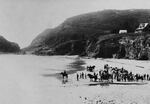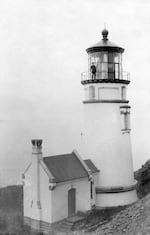On March 30, 1894, Heceta Head’s scenic lighthouse began operations. Today, that same lighthouse still illuminates the Oregon Coast.

This image, dated 1898, shows Heceta Head Lighthouse not long after it first began operation.
Courtesy of the Siuslaw National Forest Collection, Oregon State University
The federal government began building Oregon’s lighthouses in 1870 along prominent headlands and major estuaries to help guide commercial ships and fishing vessels.
Heceta Head, north of Florence, is a part of the lava flow of an extinct volcano. It stands 1,000 feet above the Pacific Ocean, providing the ideal spot for a lighthouse.

In this image from 1892, people gather on the beach below Heceta Head. Excavation for the lighthouse can be seen on the bluff.
Courtesy of Siuslaw National Forest Collection, Oregon State University
The bluff gets its name from Bruno de Heceta (or Hezeta), a Spanish navigator and explorer who surveyed the coast in 1775. Most locals pronounce it Ha-SEE-ta, though there is some debate.
Construction on Heceta Head began in 1892, long before modern roads made the area accessible. Ships transported building materials to the beach that then had to be hauled up the hillside.
Heceta’s original complex consisted of a lighthouse, housing for lightkeepers and their families, a barn and kerosene oil houses. Due to the isolated area, workers and the nearby farmers also had their own post office and a one-room schoolhouse.
By the 1930s, the Oregon Coast Highway opened traffic to the area, offering travelers frequent viewpoints to take in the dramatic scenery.
Eventually, electric bulbs replaced kerosene lamps, and in 1963 the lighthouse became fully automated.

This image, circa 1930s, shows Heceta Head from the early Oregon Coast Highway.
Courtesy of the Siuslaw National Forest Collection, Oregon State University
Today, the Heceta Head Lighthouse State Scenic Viewpoint is part of the Oregon State Park system. The lighthouse’s modern 1000-watt quartz bulb produces 2.5 million candle power, emitting one flash every 10 seconds. It remains the brightest beacon on the Oregon coast.
The lighthouse has been painstakingly renovated and is open to visitors, depending on the weather and staffing. There is also a nearby interpretive center and gift shop, while the restored assistant lightkeeper’s house serves as a bed and breakfast.

A lightkeeper stands atop the Heceta Head Lighthouse north of Florence, Ore., in an undated historical photo.
Courtesy of U.S. Forest Service - Pacific Northwest Region
RELATED
Terrible Tilly, Oregon Field Guide
Lighting the way for 150 years: Yaquina Head Lighthouse prepares for Sesquicentennial.
Vandals cause thousands in damage at Oregon’s Heceta Head Lighthouse
